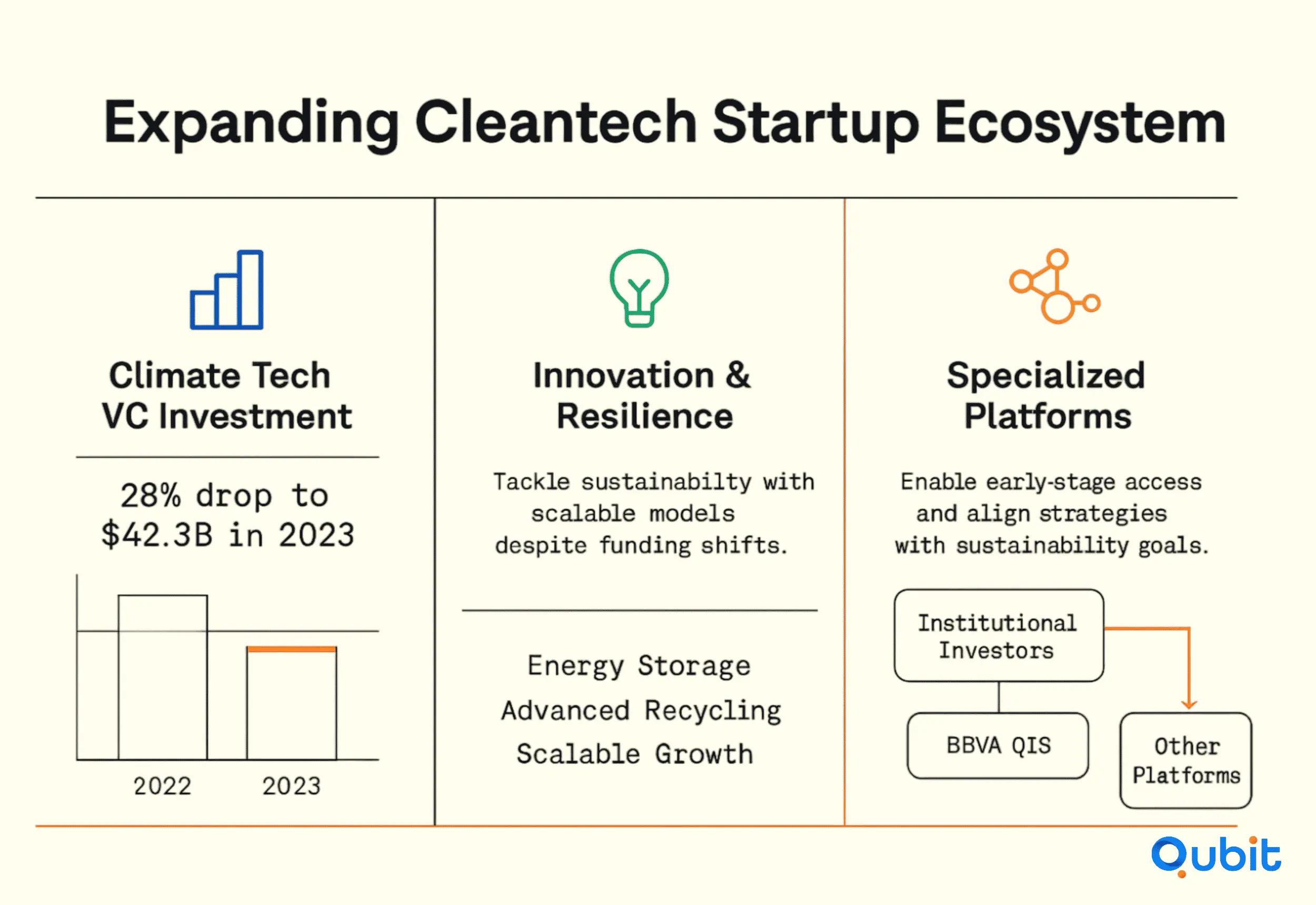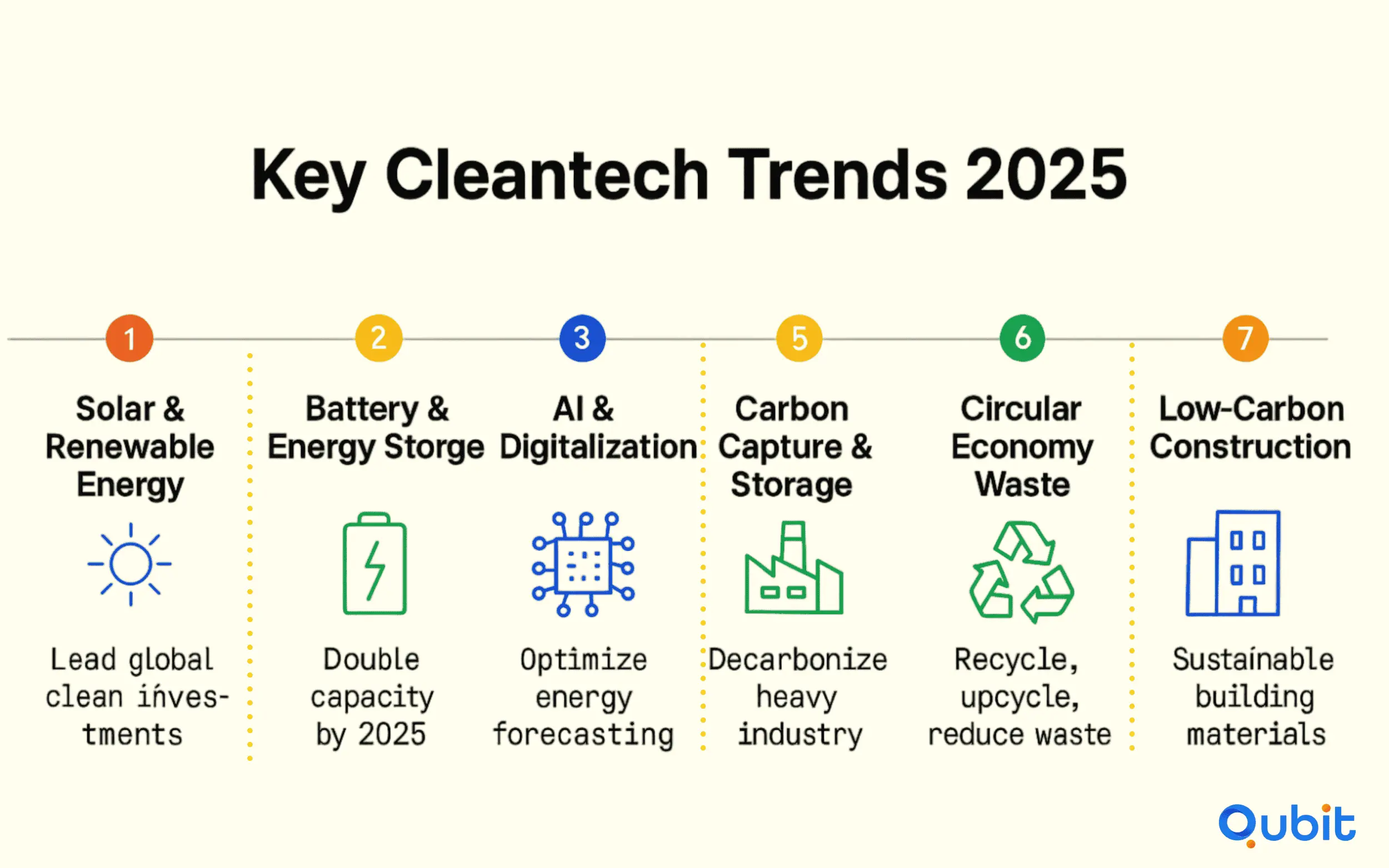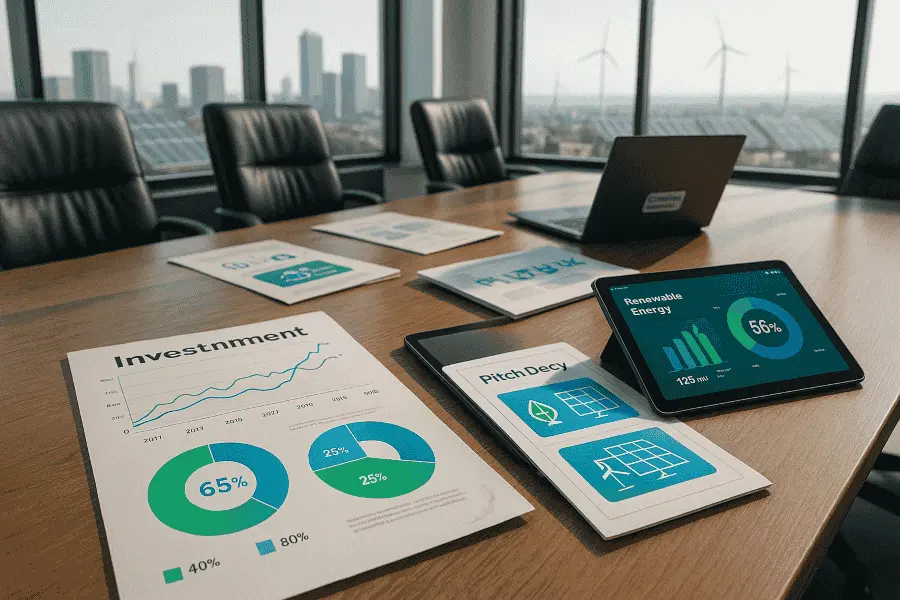The cleantech sector is rapidly evolving, capturing the attention of investors eager to support sustainable innovations. From renewable energy breakthroughs to advanced technologies that reduce carbon footprints, the industry is brimming with opportunities. As global demand for cleaner solutions intensifies, investors are focusing on trends that promise both environmental impact and financial returns.
A closer look at market innovations is supported by the narrative on green hydrogen investment, offering specific observations on how new energy technologies align with broader cleantech trends. This blog explores the emerging trends shaping cleantech investments, assessing groundbreaking innovations and actionable strategies for maximizing returns.
Did you know that cleantech investments are forecasted to hit nearly $670 billion in 2025, outpacing fossil fuel spending for the first time? Let’s jump right in.
Strategic Rationale for Cleantech Investments: Opportunities & Insights
The cleantech sector is rapidly emerging as a cornerstone of global investment strategies, driven by the urgent need for sustainable solutions and the promise of substantial returns. With a staggering $1.77 trillion global investment in low-carbon energy transition in 2023, marking a 17% increase from the previous year, the momentum behind cleantech investments is undeniable. This growth reflects the sector’s potential to redefine industries, create new markets, and address pressing environmental challenges.
The Expanding Cleantech Startup Ecosystem

Cleantech startups are at the forefront of innovation, offering diverse opportunities for investors seeking high-growth ventures. From energy storage solutions to advanced recycling technologies, these startups are tackling critical sustainability issues while delivering scalable business models. Despite a 28% drop in climate tech venture capital investments to $42.3 billion in 2023, significant deals continue to highlight the resilience and promise of this ecosystem.
The sector’s dynamism is further amplified by specialized platforms like BBVA QIS, which enable institutional investors to gain exposure to early-stage cleantech ventures. Such tools are instrumental in identifying promising startups and aligning investment strategies with long-term sustainability goals.
For a deeper dive into funding frameworks that nurture cleantech ventures, explore insights from cleantech startup fundraising strategies, which outline key challenges and opportunities in securing capital.
Innovative Financing Models for Renewable Energy Projects
Financing renewable energy projects is pivotal to advancing the cleantech sector. Innovative models, such as power purchase agreements (PPAs) and green bonds, are unlocking capital for large-scale initiatives while mitigating risks for investors. These mechanisms not only support the deployment of renewable energy but also foster the development of complementary technologies like energy storage.
Financial institutions are playing a crucial role in this transformation. For instance, BBVA CIB has positioned itself as a strategic partner in cleantech investment and financing, offering tailored funding solutions and advisory services. Such partnerships are essential for bridging the gap between innovation and implementation, ensuring that groundbreaking technologies reach the market efficiently.
The Role of Specialized Investment Funds
Dedicated investment funds are reshaping the cleantech landscape by enabling portfolio diversification and focused strategies. These funds provide investors with access to a curated selection of high-potential ventures, reducing exposure to risk while maximizing returns.
As the cleantech sector continues to evolve, the importance of specialized funds cannot be overstated. They not only streamline the investment process but also align financial objectives with environmental impact, creating a win-win scenario for stakeholders.
Why Cleantech Represents a Historic Investment Cycle
Cleantech is poised to be one of the most significant investment cycles in history, driven by the convergence of technological innovation, regulatory support, and market demand. The sector’s ability to address global challenges while generating economic value underscores its transformative potential.
Investors who recognize this opportunity are not only contributing to a sustainable future but also positioning themselves for substantial financial gains. With the cleantech ecosystem expanding rapidly and innovative financing models gaining traction, the rationale for investing in this sector has never been stronger.
Key Cleantech Trends for 2025

1. Solar PV and Renewable Energy Lead the Way
Solar photovoltaic (PV) is projected to account for half of all cleantech investments in 2025, and two-thirds of new installed capacity. This marks the first time renewable energy investments will outpace upstream oil and gas spending. However, to meet global climate targets, renewable capacity needs to triple by 2030.
2. Battery and Long-Duration Energy Storage
Energy storage solutions, especially batteries, are critical for grid stability and renewable integration. Installations are expected to double in 2025, with new technologies enhancing economic viability and mitigating price fluctuations in renewable-heavy markets.
3. Artificial Intelligence and Digitalization
AI is revolutionizing cleantech by improving energy forecasting, grid planning, and trading. AI-driven analytics help utilities and operators optimize renewable generation, reduce operational costs, and manage risks associated with variable supply.
4. Corporate Clean Energy Procurement
Large data centers and tech companies are driving demand for clean energy, increasingly sourcing power through innovative agreements. This trend is expected to accelerate, with North America leading growth in corporate clean energy procurement.
5. Carbon Capture, Utilization & Storage (CCUS)
CCUS technologies are advancing rapidly, with a focus on decarbonizing heavy industry and supporting low-carbon hydrogen production. Policy incentives and corporate interest are driving new projects and investment.
6. Circular Economy and Waste Management
Startups focused on recycling, upcycling, and circular waste management are gaining traction, offering solutions that reduce environmental impact and close resource loops.
7. Low-Carbon Construction and Green Materials
New building materials and methods are reducing emissions in the construction sector, attracting both venture and strategic investment.
8. Resilience and Climate Adaptation
Technologies that enhance climate resilience, such as water management, wildfire prevention, and infrastructure hardening—are moving into the mainstream, reflecting growing investor interest in adaptation solutions.
A closer look at market innovations is supported by the narrative on green hydrogen investment, offering specific observations on how new energy technologies align with broader cleantech trends.
Real-World Startup Successes
Despite a tighter funding environment, several startups are landing major rounds in 2025:
- Base Power raised $200 million for residential energy storage.
- Electra secured $186 million for clean iron production.
- Chestnut Carbon raised $160 million for carbon forestry projects.
These examples highlight where investors see the most promise and potential for scale.
Navigating Policy and Regulatory Landscapes
Early-stage cleantech founders operate in a sector deeply influenced by government policies, incentives, and regulatory frameworks. Proactively understanding and leveraging these factors is essential for unlocking funding, accelerating growth, and ensuring compliance. Here’s how founders can navigate this landscape effectively:
1. Monitor Key Policy Frameworks and Incentives
- Stay updated on major policy developments such as the U.S. Inflation Reduction Act and the EU’s Net Zero Industry Act, which offer substantial grants, tax credits, and incentives for clean energy, carbon reduction, and sustainable technologies.
- Track national and regional programs that provide direct funding, R&D grants, and pilot project support for cleantech startups.
2. Identify and Apply for Relevant Grants
- Explore government and multilateral funding sources, including:
- National energy and environment departments/agencies (e.g., U.S. Department of Energy, European Innovation Council)
- International bodies like the World Bank, Global Environment Facility, and regional development banks
- Local government initiatives targeting renewable energy, waste management, or carbon capture
- Prepare strong, data-driven applications that clearly articulate your technology’s impact and scalability.
3. Leverage Innovative Financing Models
- Utilize mechanisms such as Power Purchase Agreements (PPAs), green bonds, and blended finance to access capital for large-scale projects.
- Seek partnerships with financial institutions and specialized investment funds that offer tailored solutions for cleantech ventures.
4. Engage with Policymakers and Advocacy Groups
- Join industry associations and advocacy groups to stay informed about regulatory changes and upcoming funding opportunities.
- Participate in policy consultations and public comment periods to shape regulations that impact your business.
5. Understand Compliance and Reporting Requirements
- Familiarize yourself with mandatory reporting standards, such as emissions disclosures and ESG (Environmental, Social, Governance) criteria.
- Implement systems to track and report environmental impact, which can enhance eligibility for grants and attract impact-focused investors.
6. Capitalize on Emerging Trends and Technologies
- Align your business with priority areas receiving policy support, such as:
- Solar PV and renewable energy
- Battery and long-duration energy storage
- Carbon capture, utilization, and storage (CCUS)
- Circular economy and waste management
- Low-carbon construction and resilience technologies
7. Build Relationships with Corporate Partners
- Approach these partners early to validate your solution and access additional funding streams.
- Large corporates with sustainability mandates are increasingly sourcing clean technologies through procurement programs and pilot partnerships, often supported by government incentives.
Building a Data-Driven Green Business Plan
Investors increasingly expect startups to present robust, data-backed business plans. Integrating measurable sustainability metrics—such as emissions reductions, water savings, or material efficiency—into your business plan and pitch deck enhances credibility. Utilizing environmental impact assessment tools and ESG (Environmental, Social, Governance) reporting frameworks can help demonstrate both financial and environmental value to potential backers.
Funding Mix and Capital Stack Strategy
Cleantech ventures often require a blend of funding sources beyond traditional venture capital. Exploring options such as green bonds, government grants, catalytic capital (philanthropic or mission-driven investments), and debt financing can help reduce early equity dilution and finance capital-intensive R&D. A strategic funding mix can also help bridge the “valley of death” between prototype development and commercialization.
The Power of Peer Networks and Mentorship
Joining founder networks, accelerators, and mentorship programs tailored for cleantech entrepreneurs provides critical support. These communities offer shared learning, access to investors, and connections to partners who understand sector-specific challenges. Peer support can accelerate problem-solving, foster innovation, and open doors to new business opportunities.
Overcoming the Capital-Intensive Nature of Cleantech
Cleantech startups face high upfront costs for hardware, pilots, and infrastructure. Strategies such as phased pilot projects, strategic corporate partnerships, and leveraging public funding can validate technology and de-risk private investment. Structuring trial projects to collect performance data is essential for unlocking subsequent funding rounds.
AI, IoT, and Digitalization
Artificial intelligence, IoT sensors, and digital platforms are not just trends, they are essential tools for optimizing operations, reducing costs, and attracting investment in cleantech. Startups can use these technologies for predictive maintenance, energy management, and supply chain optimization, making their solutions more attractive to both customers and investors.
Corporate Partnerships and Procurement Pathways
Partnering with large corporates, especially those with aggressive sustainability targets—can provide early validation, funding, and market access. Steps for success include approaching corporate procurement teams, structuring pilot agreements, and leveraging these relationships to scale up operations.
International Expansion and Market Entry
Many cleantech solutions have global relevance. Researching international markets, understanding regional funding trends, and navigating cross-border partnerships are key to scaling. Tailoring strategies for different regulatory environments and customer needs can accelerate international growth.
Looking Ahead: What’s Next?
2025 is a pivotal year for cleantech. With clean energy investment set to outpace fossil fuels and new technologies reshaping the sector, the next wave of growth will come from AI-driven optimization, electrification of transport and industry, and large-scale adoption of circular economy principles.
Conclusion
The cleantech sector offers immense potential for both innovation and investment. By focusing on emerging trends and adopting data-driven strategies, businesses can position themselves at the forefront of this transformative industry. Innovative financial models are proving essential in addressing the unique challenges of cleantech investments, while a compelling pitch deck—built around a strong narrative, remains critical for attracting the right stakeholders.
At Qubit Capital, we understand the importance of connecting startups with the right investors to drive meaningful progress. If you're ready to explore tailored investment opportunities, our Startup Matchmaking service is here to guide you toward success.
Key Takeaways
- Cleantech investments are set to surpass fossil fuels in 2025, with solar PV leading the charge.
- Battery storage, AI, and carbon capture are critical areas of innovation and investment.
- Corporate clean energy procurement and resilience technologies are accelerating sector growth.
- Innovative financing models and specialized funds are unlocking new opportunities for investors.
- Cleantech’s historic investment cycle is driven by a convergence of technology, policy, and market demand.
Frequently asked Questions
What are the latest trends in cleantech investments?
Cleantech investments are expanding into innovative areas such as green hydrogen, advanced energy storage technologies, and the electrification of transportation. These developments are fueling projections of nearly $800 billion in clean energy technology investments by 2024.


 Back
Back



